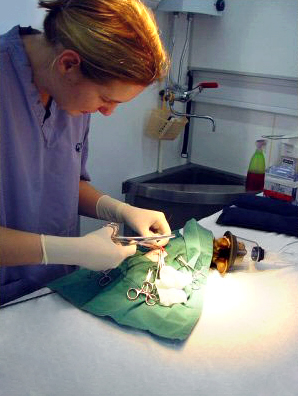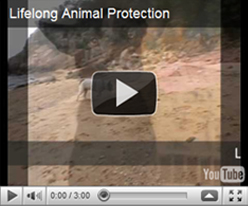Many colonies of feral cats have formed on Lamma around food sources such as refuse
collection points and restaurants. In addition some are fed by kind individuals.
The lives of these cats are hard and short, filled with fear, hunger and disease.
Life expectancy is no more than three years. It is particularly hard for a female
as she spends most of her life pregnant or nursing. Illnesses, parasites, injuries
and human malice claim the lives of most of her kittens but those that survive continue
the circle.
Not only do these cats suffer but they act as a reservoir for disease and the sight
of sick and dying animals is distressing. Catching and killing or poisoning feral
animals is costly but ineffective as those killed are quickly replaced - quite apart
from the suffering inflicted on the animals.
Eradication programmes have a very poor record of success worldwide.
A particular problem on Lamma is created by people who leave the island and abandon
their companion animals, supposing that they can survive in the wild.
In fact, domestic cats and dogs generally cannot fend for themselves, live in confusion
and die slowly from malnutrition and disease. Meanwhile they may well breed if they
are not neutered. In addition domestic animals from other areas are often brought
to outlying islands and dumped there by owners who no longer want them or are not
permitted to keep them in their apartments.
|
|

|

|
|
|
The LAP TNR Programme |
With the generous veterinarian support of Dr. Hans De Vries and HKSPCA and in cooperation
with AFCD, a programme of “Trap/Neuter/Release” (TNR) has been set up to address
the problem in a humane and cost-effective way. The goal is to achieve a stable
population of healthy non-breeding animals.
Targeting one colony at a time, the cats are fed and watered daily, then trapped
individually, treated, vaccinated, sterilised and either released back into the
colony or fostered and homed whenever this is feasible. The first targeted colony
was estimated to have been producing around 50 kittens per season, beyond a sustainable
level.
These died of disease and hunger, often lost or were abandoned by people around
refuse collection points. Some of these may have been imported into the area by
people who then would not take responsibility for them or whose domestic cats had
given birth to unwanted kittens. Since the programme was initiated this has been
reduced to four a year. The improvement in the general health of the colony is plain
to see. Similar results have been achieved with other colonies. LAP continues to
provide food and water after release.
To avoid repetition, treated cats have one ear clipped while anaesthetised. This
heals rapidly and, as the hair grown back, in not visible/noticeable except at close
range.
The TNR treatment clearly does not traumatise the cats. On the contrary, one of
the main difficulties in achieving 100% treatment of fertile cats in a colony is
that graduates of the programme return confidently to the traps for a safe meal.
We operate on cats from 2 months and older as it is better to do it before sexual
maturity. We advocate EARLY AGE SPAY AND NEUTER.
|
|

|
|
Adoption |
While TNR is a compassionate and pragmatic solution to the feral cat overpopulation
problem, the unacceptable conditions in which a feral cat must survive bear no comparison
with adoption by a loving home. LAP makes every effort to find homes for friendly
cats and to foster kittens until this can be arranged.
Where a cat has been injured or maimed it is not returned to the colony in that
condition. |
|
The Sick and Injured |
The very first cat trapped by LAP had been horribly abused. She had 3rd degree burns
to 40% of her skin.
We worked to save her and now she is a gorgeous and happily homed cat. Sadly, every
decision on whether to attempt to save the life of an animal is a compromise between
her chances of survival and money available. LAP will continue to give every animal
a chance as far as our resources allow. |
|
|

|

|
Spay or neuter your own cat.
The value of the TNR programmed is clear but the other main sources of abandoned
animals must be stopped. Breeding by feral animals is only part of the problem,
we must all spay and neuter our own companion animals so that uncontrolled breeding
and accidental pregnancy do not lead to more unwanted kittens.
|
|
|

|
Donate food or money for trapping or maintenance. Contribute to the cost of maintaining
the treated colonies. LAP has no funding from official sources and depends entirely
on the generosity of people like you both for money and for practical help.
|
|
|

|
Identify a colony you would like to care for. We will help you trap and sterilise
them.
|
|

|

|
Donate to help with transport costs. We and the cats must travel by ferry and taxi.
|
|
|

|
Foster an injured or young cat. This is a short term and very rewarding experience.
All the love with no long term commitment, and the pleasure of knowing you have
saved a life.
|
|
|

|
Adopt one of the rescued, kittens or friendly cats.
|
|
|

|
LAP promotes Humane Education by giving talks, showing videos and presentations
in schools, companies and individual gatherings. LAP believes that kindness, respect
and responsibility must be part of education in our community.
|
|
|
|

|
|
LAP Video
|

|
|

|
|
|
|
|